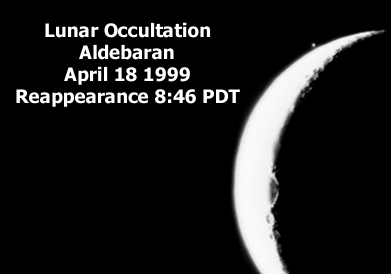|
|
Observer's Archives - April 1999Website archive 1995-2013 |
Victoria Centre is part of the national Royal Astronomical Society of Canada, which is dedicated to bringing information about astronomy to the general public. |
|
|
|
|
Lunar Occultation on April 18 1999 Sunday morning it seemed doubtful that the weather would cooperate with the our video capture of the Moon-Aldebaran Occultation. The idea of capturing the event on video was suggested by Kelly, one of the Pearson College students participating in the astronomy program at the College's Observatory. Kelly wanted to get some accurate timings of the event. After looking at some of the articles on timing occultations on the Sky and Telescope website I didn't think this would be a difficult thing. The plan was to videotape the event with a camcorder. Many of the articles on the topic suggest the use of a recent camcorder with a 12x zoom. The recorder I had to use had a 8x zoom and is not considered a low-light device. Images are quite grainy when there is inadequate light. My understanding is most recent cameras have very good low-light capability. Given the nature of the older camera I asked Keith Rawcliffe if we could use his GBC video camera head without lens which is designed for light as low as .01 lux. It also has an adjustable gain which allows you to adjust the image quality. With an adapter that can be attached to any telescope with a 1-1/4" eyepiece holder this would be the ideal solution. The Televue Pronto with its wide field of view was used on its Super Polaris Mount. Now the camcorder would only be used as a portable VCR, recording from the low-light video camera. For a time signal we used a portable SW radio tuned to WWV whose output was directed into the audio of the camcorder. A call from Richard Harvey, our astronomer-weatherperson, reassured me that based on his interpretation we had a very good chance of clear skies. For me that was good enough. One thing you do learn on the West Coast about the weather is you can't wait for a sure thing otherwise you would never do any observing. Richard has a very good track record and I was very pleased when the evening had perfectly clear skies. Capturing the disappearance of Aldebaran proved to be a little
harder than we thought. This was the first time we used Keith's
GBC video camera on the Pronto. The first obstacle was the still
light sky which made finding the thin crescent moon a bit of a
challenge. Needless to say we missed the disappearance but we
did watch it visually. We timed the disappearance to be at 8:07:13
PDT. This was based on Steve's observation who was set up beside
us using binoculars. Ok we were close ! We estimate the disappearance to be April 18, 1999 8:46:37 PDT. - DL April 20th, 1999 
|
|